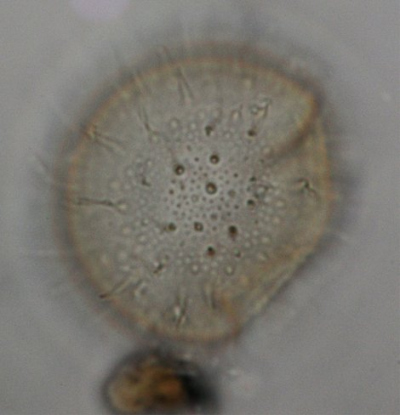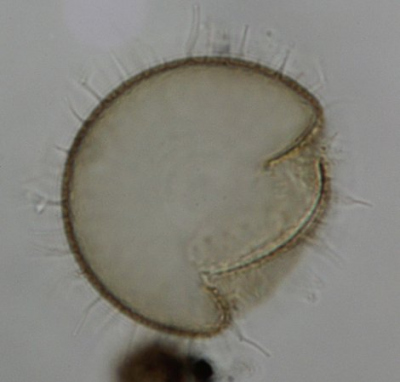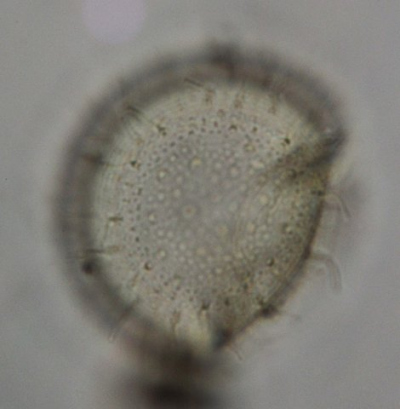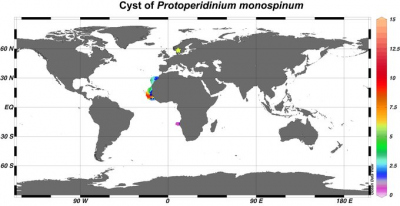Die Inhalte dieser Seite sind leider nicht auf Deutsch verfügbar.
Seitenpfad:
- Modern Dinocyst Key
- brown cysts
- spherical brown randomly distributed processes
- spherical brown cysts with two types of processes
- cysts of Protoperidinium monospinum
cysts of Protoperidinium monospinum
Zonneveld, K.A.F. and Pospelova V. (2015). A determination key for modern dinoflagellate cysts. Palynology 39 (3), 387- 409.



lateral view
photo: Karin Zonneveld
photo: Karin Zonneveld
cross section
photo: Karin Zonneveld
photo: Karin Zonneveld
lateral view 2
photo: Karin Zonneveld
photo: Karin Zonneveld
Field characteristics
Cysts of Protoperidinium monospinum (Paulsen 1907) Zonneveld et Dale 1984 Plate 8, Fig. 5.
Field characteristics:
The cysts of Protoperidinium monospinum are subspherical and pale brown in colour. The cell content is grey-brown. Cysts are covered with many, randomly distributed processes of two different types. One type is larger, hollow and capitate, bifurcated or double branched at the distal ends. The other type is solid, acuminate and scattered randomly between the large processes. The cyst opens with a split archeopyle which cannot be unequivocally assigned to an equivalent tabulation.
Dimensions: The cysts are 28 - 40 μm long and 28 - 40 μm wide. The hollow spines vary in length from 3 μm to 7μm. The solid spines are equal in length and about 3 μm long.
Motile affinity: Protoperdinium monospinum
Stratigraphic range: recent
Field characteristics:
This species differs from all other cysts in having two different process types on the same cyst with large processes being hollow, capitate, bifurcated or double branched and small processes being acuminate and solid.
Field characteristics:
The cysts of Protoperidinium monospinum are subspherical and pale brown in colour. The cell content is grey-brown. Cysts are covered with many, randomly distributed processes of two different types. One type is larger, hollow and capitate, bifurcated or double branched at the distal ends. The other type is solid, acuminate and scattered randomly between the large processes. The cyst opens with a split archeopyle which cannot be unequivocally assigned to an equivalent tabulation.
Dimensions: The cysts are 28 - 40 μm long and 28 - 40 μm wide. The hollow spines vary in length from 3 μm to 7μm. The solid spines are equal in length and about 3 μm long.
Motile affinity: Protoperdinium monospinum
Stratigraphic range: recent
Field characteristics:
This species differs from all other cysts in having two different process types on the same cyst with large processes being hollow, capitate, bifurcated or double branched and small processes being acuminate and solid.
Geographic distribution
Geographic distribution based on :
Zonneveld et al., 2013. Atlas of modern dinoflagellate cyst distribution based on 2405 datapoints. Review of Palaeobotany and Palynology, v. 191, 1-197
Zonneveld et al., 2013. Atlas of modern dinoflagellate cyst distribution based on 2405 datapoints. Review of Palaeobotany and Palynology, v. 191, 1-197
Cysts of Protoperidinium monospinum are characteristically present in full marine, tropical to equatorial upwelling areas off NW Africa. Seasonally, cysts are produced when active upwelling occurs in the vicinity of the sampling sites.

Distribution:
Cysts of Protoperidinium monospinum is exclusively observed in coastal sites of the subtropical to equatorial upwelling areas off NW Africa (eastern equatorial Atlantic Ocean) except for one coastal site off SW Africa. Highest abundances (up to 12%) occur in the vicinity of upwelling cells off NW Africa.
Environmental parameter range:
SST: 16.0 - 29.1°C (winter - summer), SSS: 32.8 - 36.0 (autumn - summer), [P]: 0.1 - 0.7 μmol/l, [N]: 0.5 - 7.9 μmol/l, chlorophyll-a: 0.2 - 12.2 ml/l, bottom water [O2]: 0 - 5.5 ml/l.
Highest abundances of cysts of Protoperidinium monospinum are observed in upwelling areas where large inter-annual variability in the trophic state of the upper waters can occur with eutrophic conditions during active upwelling or when upwelling filaments cross the sampling site and oligotrophic conditions otherwise.
Comparison with other records:
Apart from the records in the dataset of this Atlas, cysts of Protoperidinium monospinum have been isolated and cultured from sediments of the Oslo Fjord (Zonneveld and Dale, 1994). Furthermore, they have been documented from sediment trap samples from the Gulf of Napels (Mediterranean Sea (Montresor et al., 1998). This suggests that the distribution documented by this Atlas might be a severe underestimate.
In sediment trap studies off NW Africa cysts of P. monospinum are produced when active upwelling occurs in the vicinity of the trap sites or when upwelling filaments cross the trap position (Susek et al., 2005; Zonneveld et al., 2010). In the Gulf of Napels cysts were recovered in spring and autumn (Montresor et al., 1998).
Cysts of Protoperidinium monospinum is exclusively observed in coastal sites of the subtropical to equatorial upwelling areas off NW Africa (eastern equatorial Atlantic Ocean) except for one coastal site off SW Africa. Highest abundances (up to 12%) occur in the vicinity of upwelling cells off NW Africa.
Environmental parameter range:
SST: 16.0 - 29.1°C (winter - summer), SSS: 32.8 - 36.0 (autumn - summer), [P]: 0.1 - 0.7 μmol/l, [N]: 0.5 - 7.9 μmol/l, chlorophyll-a: 0.2 - 12.2 ml/l, bottom water [O2]: 0 - 5.5 ml/l.
Highest abundances of cysts of Protoperidinium monospinum are observed in upwelling areas where large inter-annual variability in the trophic state of the upper waters can occur with eutrophic conditions during active upwelling or when upwelling filaments cross the sampling site and oligotrophic conditions otherwise.
Comparison with other records:
Apart from the records in the dataset of this Atlas, cysts of Protoperidinium monospinum have been isolated and cultured from sediments of the Oslo Fjord (Zonneveld and Dale, 1994). Furthermore, they have been documented from sediment trap samples from the Gulf of Napels (Mediterranean Sea (Montresor et al., 1998). This suggests that the distribution documented by this Atlas might be a severe underestimate.
In sediment trap studies off NW Africa cysts of P. monospinum are produced when active upwelling occurs in the vicinity of the trap sites or when upwelling filaments cross the trap position (Susek et al., 2005; Zonneveld et al., 2010). In the Gulf of Napels cysts were recovered in spring and autumn (Montresor et al., 1998).


